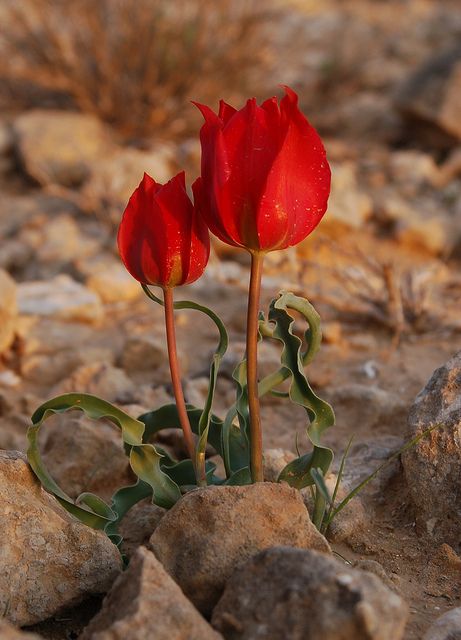Tulip is an obsession. There is something special about it, the way its fleshy flowers and leaves feel is more like living skin than plant.
In the 17th century this flower lead a popular craze, an epidemic devotion, escalating to a kind of “tulipomania”, that started in Holland and swept most of Europe. One bulb of a certain variety of tulip would sell, in the 1630s, for hundreds of thousands of dollars. Today the global tulip market has grown to match the national economy of an average size country.
As this plant is not found in Holland in the wild, could it be that the Dutch tulip tradition has some long-lost connection to the wild tulips of Jordan?

Historians in Europe trace this magical bulb to the Ottoman Empire, with great accounts and stories illustrating the importance of tulip in the Ottoman high civilization. When looking beyond Turkey, western historians sketch only a hazy image. Behind the Ottoman Empire; references usually locate the origin of the flower to remote places between Mongolia, China and Kazakhstan. But why look for the origin of tulip that far, it would have been closer for the Ottomans to bring the first bulbs from Mount Lebanon, Palestine or Jordan.
It would have been closer for the Ottomans to bring the first bulbs from Mount Lebanon, Palestine or Jordan.
Three known kinds of tulip have been identified in the wild in Jordan: two kinds with red flower and one “Desert Tulip” with a whitish flower. The two red ones are very similar, both species grow in basically the same habitat; mountains, and natural forests across Irbid, Ajloun, Jerash, Salt, Amman and Tafileh. Some flowers of these two species can get closer to orange, especially on the outer face of the petals, while few are striped with yellowish lines. From the inside, the flower has a black spot as a base, demarcated with a yellow borderline.

From these two species of Jordanian red tulip, “Tulipa agenensis” and “Tulipa stylosa”, the first seems to prefer sandy, well-drained semi-forested hillsides (low lands around Jerash, and slopes overlooking the Jordan valley) and within the Mediterranean vegetation habitat at the altitude between sea-level and up to 700m. The second “Tulipa stylosa” seems not to mind the colder, higher, and snowy lands around Amman, of 700 to 1000 meters in elevation.
The third kind of wild tulip found in Jordan, the Desert Tulip (Tulipa polychroma) has a slightly smaller flower, elegantly articulated with more than one color, as its scientific name suggests. The Desert Tulip also gives, sometimes, more than one flower on a branching stem. Its color is of beautiful ivory-white with brownish waxy stripes on the outside, and a ring of bright yellow provides the base of the flower with an eye-catching charm. The Desert Tulip grows in the highlands of Shobak, Ras al Naqab, and parts of the eastern desert.

All three kinds of wild tulip identified in Jordan, so far, have jagged leaves with wavy margins. When leaves are in good shade, this feature is lost making the waxy leaves more similar to cultivated tulip found in the market. The feature of “waves”, that gives the leaves the appearance of some aquatic creature, is an important detail if one attempts to tie Jordan’s species to the Ottoman tulips found decorating Iznik tiles. Both the distinctive leaves and the pointed flowers, typical of the Ottoman decorative motifs, make the Jordanian wild tulip a strong possible link in the story of the origin of this flower.
The Desert Tulip gives, sometimes, more than one flower on a branching stem. It grows in the highlands of Shobak, Ras al Naqab, and parts of the eastern desert.
The old world, the Levant, of which Jordan represents a central part, has given the new world its wheat, and many of its domesticated food-plants. As for flowers, bulbs sold in the world markets such as tulip, crocuses, daffodils, saffron, and narcissus, are all found in Jordan in the wild. Other than bulbs, flowers such as carnation, iris, anemone, and orchid, are also found as part of Jordan’s richly blooming ground-cover.
This post is available in: English Español

